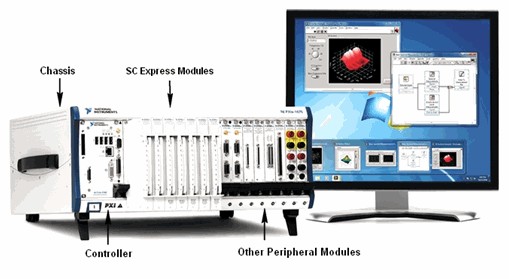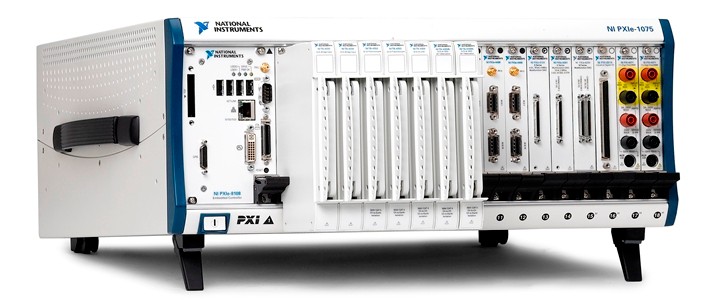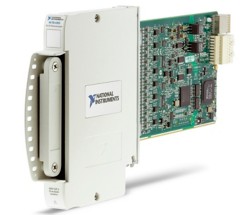Integrated Signal Conditioning Meets PXI Express
Overview
NI offers PXI Express data acquisition with integrated signal conditioning for measuring strain gages, bridge-based transducers, thermocouples, and high-voltage analog input signals. Increased accuracy, high data throughput, and tight synchronization are key features that make this family ideal for advanced measurement systems from low to high channel counts. These modules were sometimes previously referred to as SC Express module.
Contents
- Achieving Better Measurement Accuracy
- PXI Express Dedicated Data Throughput
- PXI Platform Advanced Timing and Synchronization
- Measuring Strain Gages and Bridge-Based Transducers on PXI Express
- Measuring Thermocouples on PXI Express
- Measuring High Voltages on PXI Express
- Conclusion
Achieving Better Measurement Accuracy

Figure 1: SC Express data acquisition (DAQ) modules include integrated signal conditioning for measuring sensors and high voltages.
Many sensors require signal conditioning before output can be accurately digitized. Examples of signal conditioning include amplification, excitation, isolation, and filtering. For many years, engineers implemented signal conditioning through separate front-end systems cabled to a data acquisition system that converted the conditioned analog signals to digital. New technologies and miniaturization have recently made it possible for companies to integrate signal conditioning and analog-to-digital conversion into the same device to deliver higher-accuracy measurements by eliminating error-prone cabling and connectors. These modules for each measurement type have unique design implementations to allow better accuracy, including low isothermal error for thermocouple measurements and no dependence on excitation voltage accuracy for bridge-based measurements.
| Module | Measurement Type | Channels | Sample Rate | Accuracy |
| NI PXIe-4300 | Isolated AI | 8 | 250 kS/s/ch | 2.46 mV |
| NI PXIe-4330 | Strain, load, pressure, and torque | 8 | 25 kS/s/ch | 0.02% of reading |
| NI PXIe-4331 | Strain, load, pressure, and torque | 8 | 102.4 kS/s/ch | 0.03% of reading |
| NI PXIe-4353 | Thermocouple | 32 | 90 S/s/ch | 0.30 °C |
Table 1: You can use these models to achieve high measurement accuracy.
PXI Express Dedicated Data Throughput
These modules are built on the x1 PXI Express bus with dedicated bandwidth per device up to 250 MB/s. Because of the added bandwidth PXI Express provides, the modules offer simultaneous sampling options using the same channel counts and connectivity as multiplexed devices. Unlike multiplexed devices that reduce sampling rates as you add more channels, you can use simultaneous sampling devices to maintain sampling rates as you expand the number of channels.
PXI Platform Advanced Timing and Synchronization
The PXI platform has delivered advanced timing and synchronization to measurement systems for more than 10 years. Building on PXI capabilities, PXI Express provides the additional timing and synchronization features of a 100 MHz differential system clock, differential signaling, and differential star triggers. By using differential clocking and synchronization, PXI Express systems benefit from increased noise immunity for instrumentation clocks and the ability to transmit at higher-frequency rates. PXI Express delivers tight synchronization between modules in one chassis or multiple chassis. When synchronized with the more than 1,500 modules in the PXI platform, you have the flexibility to develop a measurement system that meets the needs of your application.
Figure 2: Synchronize with more than 1,500 I/O types on the PXI platform.
Measuring Strain Gages and Bridge-Based Transducers on PXI Express
The NI PXIe-4330 and NI PXIe-4331 24-bit simultaneous bridge input modules offer 0.03 percent typical accuracy and up to 102.4 kS/s per channel sample rate for high-performance strain, load, force, and torque measurements. The bridge input modules achieve high accuracy with a ratiometric design where the analog-to-digital converter (ADC) references the excitation voltage. This approach removes the measurement’s dependence on the stability and accuracy of the excitation voltage. In addition, unique delta-sigma ADCs are used to provide both excellent AC performance and DC accuracy, a distinctive feature considering traditional delta-sigma ADCs provide only good AC specifications.
The NI PXIe-4330 and NI PXIe-4331 can perform quarter, half, and full bridge-based measurements with automatic synchronization features; the included driver software ensures tight synchronization across multiple modules and chassis with inter-channel skews as low as 5 ppb. These devices offer per channel excitation from 0.625 to 10 V with remote sensing to compensate for error caused by resistance in the wires connecting the voltage source to the bridge. For added flexibility, built-in bridge completion (120 W, 350 W, and 1 kW) and shunt calibration (50 kW, 100 kW) are software-selectable on a per channel basis. You can use the NI PXIe-433x with the NI TB-4330 front-mounting terminal block to directly connect signals and sensors.
Measuring Thermocouples on PXI Express
With the NI PXIe-4353 thermocouple module, you can measure temperatures with .30 °C typical accuracy and 24-bit resolution on 32 channels. The NI TB-4353 isothermal terminal block, which provides powerful cold-junction compensation (CJC), achieves the high-accuracy levels. CJC improves your measurement accuracy by providing the temperature at the cold junctions and applying the appropriate correction. The isothermal terminal block minimizes error with a unique design that optimizes thermal conductivity, making it possible for the nearby CJC thermistors to accurately measure the temperature at the thermocouple junctions. The TB-4353 front-mounting terminal block includes eight CJC thermistors that are distributed on the terminal block to closely measure the cold junctions across the terminal block.
Figure 3: You can use the NI PXIe-4353 with the TB-4353 front-mounting terminal block for screw terminal connectivity.
For increased performance, the NI PXIe-4353 shares its inputs across three different ADCs and supports multiple timing modes (90 S/s/ch max) to balance the trade-off between speed versus accuracy and noise rejection. The module also includes 300 Vrms CAT II bank isolation to allow flexibility in the environments and eliminate crosstalk. With bank isolation, you can connect floating thermocouples and thermocouples with a common mode voltage of up to 300 V relative to the chassis ground. Additionally, the module has two auto-zero channels to compensate for offset error, as well as open thermocouple detection circuitry on each channel.
Measuring High Voltages on PXI Express
The NI PXIe-4300 simultaneously measures eight differential high-voltage analog inputs up to ±300 V. This module features 300 Vrms channel-to-channel CAT II isolation and 3,300 Vrms channel-to-earth five-second withstand to protect users and equipment from hazardous voltages. Measurement Category II is for measurements performed on circuits directly connected to the electrical distribution system. This category refers to local-level electrical distribution, such as that provided by a standard wall outlet, for example, 115 V for the United States or 230 V for Europe.
With a 16-bit ADC per channel and a 250 kS/s per channel sampling rate, the NI PXIe-4300 module can stream 4 MB/s per module and 68 MB/s in a single chassis. Because the NI PXIe-4300 uses PXI Express technology, you can simultaneously acquire channels from dozens of modules at maximum sample rate without reaching communication bus limitations. To remove high-frequency noise, the NI PXIe-4300 also includes programmable lowpass filters (10 kHz, 100 kHz, bypass) per channel.
You can choose the NI TB-4300 terminal block for ±10 V signal inputs or NI TB-4300B terminal block for ±300 V signal inputs. The TB-4300 is strictly a feedthrough terminal block. The TB-4300B provides 30:1 attenuation to the input signal with additional high-voltage protection circuitry. Scaling constants are stored in the EEPROM and used by software to automatically apply scaling to the signal band of the selected range. The TB-4300 and TB-4300B are front mounting terminal blocks with screw terminal connectivity.
Conclusion
This hardware offers the highest performing data acquisition and signal conditioning on the PXI platform. With increased accuracy, high data throughput, and best-in-class synchronization, you can design a flexible and scalable data acquisition system for low- to high-channel-count applications. National Instruments advanced PXI Express technology and ease-of-use software features give you the power to decrease development time and meet the most demanding measurement requirements.


